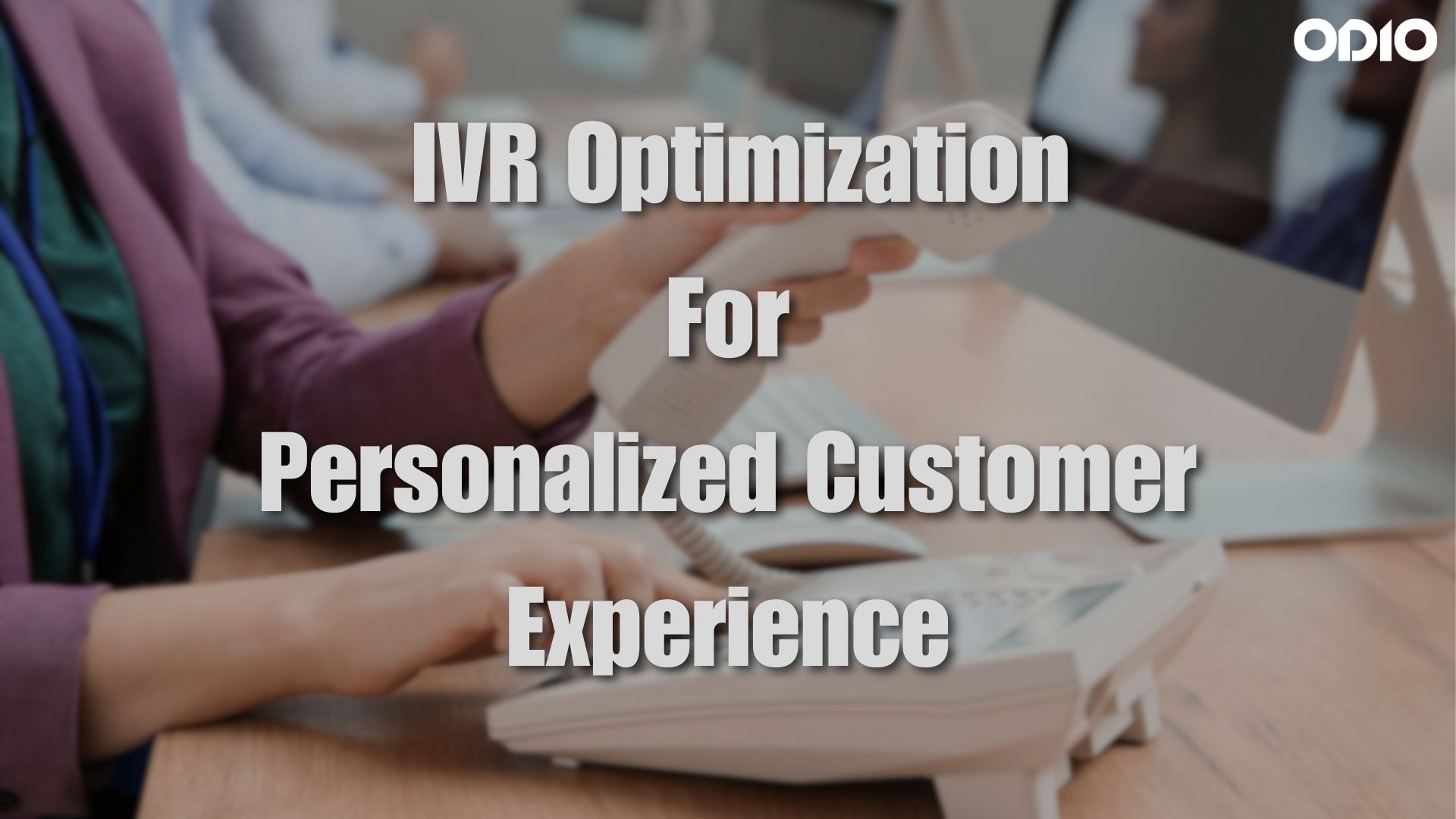
In the fast-paced realm of customer service, the lifeline for businesses lies within contact centers. Picture this: a staggering 86% of customers are willing to pay more for a better customer experience. As we unravel the complexities of Interactive voice response (IVR) optimization, we embark on a journey to redefine and personalize the customer experience within contact centers.
Understanding the emotional nuances of customers is pivotal in the ever-evolving landscape of customer service. The role of contact centers extends beyond mere problem-solving; it’s about crafting memorable experiences that resonate with each individual.
What is a Contact Center Interactive Voice Response (IVR)?
At the heart of this transformation is the Contact Center Interactive Voice Response (IVR) system. IVR serves as the digital concierge, guiding customers through a menu of options to reach their desired destination. It’s the first point of contact, a digital handshake that sets the tone for the customer’s journey.
The Evolution of Contact Center Interactive voice response (IVR)
The journey of Interactive voice response (IVR) in contact centers has undergone a remarkable evolution. From its inception as a simple routing system to the sophisticated interactive platforms of today, IVR has transcended its initial purpose. It has metamorphosed from a basic directional tool to a personalized gateway that anticipates customer needs.
The early stages of Interactive voice response (IVR) were primarily about efficiency – reducing call wait times and streamlining processes. As technology advanced, so did the capabilities of IVR. It evolved into a dynamic interface, capable of understanding natural language, recognizing customer sentiments, and adapting to individual preferences.
This evolution has brought about a shift in focus, from mere functionality to the creation of a seamless and personalized customer journey. Interactive voice response (IVR) has become a strategic asset, not just for contact centers but for businesses aiming to cultivate lasting relationships with their customers.
How Does the Contact Center Interactive voice response (IVR) Work
Now, let’s unravel the mechanics behind the scenes. The contact center IVR operates as a sophisticated gatekeeper, equipped with advanced technologies to ensure a seamless customer journey.
- 1. Automated Call Routing: Interactive voice response utilizes automated call routing to direct customers to the appropriate department or agent, minimizing wait times and ensuring swift issue resolution.
- 2. Natural Language Processing (NLP): Modern Interactive voice response systems leverage NLP to comprehend and respond to natural language input. This not only enhances user experience but also allows for a more personalized interaction.
- 3. Customer Sentiment Analysis: Understanding the emotions of customers is a game-changer. IVR systems now incorporate sentiment analysis, gauging the tone of voice and adjusting responses accordingly. This emotional intelligence enhances customer engagement.
- 4. Personalized Menu Options: Interactive voice response has transcended static menus. It now tailors menu options based on customer history, preferences, and previous interactions. This personalization contributes significantly to the overall customer experience.
Optimizing Contact Center Interactive voice response (IVR)
The journey towards customer satisfaction doesn’t end with understanding how IVR works; it’s about optimizing its functionality to elevate customer engagement. IVR optimization is the key to unlocking its full potential.
- 1. Streamlined Call Flows: Optimization begins with simplifying call flows. A convoluted menu can lead to frustration. Streamlining options ensures customers navigate effortlessly.
- 2. Personalization Algorithms: Integrate algorithms that analyze customer data to provide personalized menu options. This ensures customers feel understood and valued, fostering a sense of loyalty.
- 3. Continuous Monitoring and Adaptation: IVR systems should be dynamic. Regularly monitor customer interactions, gather feedback, and adapt the IVR accordingly. This iterative process ensures ongoing optimization.
Emerging Trends in Interactive voice response (IVR) and Customer Service
As we step into the future, the trajectory of Contact Center IVR is intertwined with broader trends in customer service. The evolution witnessed thus far is merely a prelude to what lies ahead. Businesses that aim to stay ahead must be proactive in adopting emerging technologies and strategies that align with evolving customer expectations.
AI and Machine Learning Integration:
The integration of artificial intelligence (AI) and machine learning (ML) will be a cornerstone of the future of Contact Center IVR. These technologies will enable IVR systems to learn from each interaction, continuously improving their understanding of customer needs and preferences. This iterative learning process ensures a more refined and efficient IVR experience.
Augmented Reality and Visual IVR:
The future may see the incorporation of augmented reality (AR) into IVR systems, introducing a visual dimension to customer interactions. Visual IVR can provide users with a more immersive and interactive experience, especially when troubleshooting complex issues. This evolution aligns with the growing demand for multi-sensory and visually engaging customer interactions.
Blockchain for Enhanced Security:
As data security becomes an increasingly critical concern, the future of Contact Center IVR may witness the integration of blockchain technology. Blockchain can enhance the security of customer data, providing a transparent and tamper-resistant framework for storing sensitive information. This not only builds trust but also ensures compliance with stringent data protection regulations.
Voice Biometrics for Personalized Authentication:
To further enhance security and personalization, voice biometrics may become a prominent feature in IVR systems. This technology allows for secure and seamless customer authentication through voice recognition. The future of IVR will likely see a shift towards more robust and personalized identity verification methods.
Continuous Customer Feedback Loop:
In the future, the emphasis on customer feedback will become even more pronounced. IVR systems will be designed to gather real-time feedback, allowing businesses to adapt and optimize their customer service strategies dynamically. This continuous feedback loop ensures that IVR remains aligned with customer expectations and preferences.
Preparation for the Future Landscape:
As businesses navigate the evolving landscape of Contact Center IVR, strategic preparation is paramount. This involves staying informed about emerging technologies, understanding customer trends, and adapting IVR strategies accordingly. By proactively embracing change, businesses can position themselves to provide exceptional customer experiences in the future.
Conclusion
The journey through the world of Contact Center IVR has been a fascinating exploration of its evolution, optimization, and future prospects. As businesses prepare for the future, the key lies in strategic alignment, technological integration, and a relentless focus on personalized customer experiences. What’s next for Contact Center IVR and customer service? The future awaits, and the possibilities are as dynamic as the evolving needs of customers. How will your business shape the future of customer interactions?
Frequently Asked Questions (FAQs)
Q: How does Interactive voice response (IVR) optimization contribute to personalized customer experiences in contact centers?
A: Interactive voice response (IVR) optimization enhances personalized customer experiences by utilizing advanced technologies like AI and machine learning. It tailors responses based on customer data, recognizes individual preferences, and proactively addresses customer needs, making interactions more personalized and engaging.
Q: Is IVR functionality limited to call routing, or does it offer more sophisticated features?
A: While IVR does handle call routing efficiently, its functionality goes beyond that. Modern IVR systems are equipped with AI and natural language processing, allowing them to comprehend and respond intelligently to customer queries. This advanced functionality contributes to a more seamless and interactive customer experience.
Q: How can businesses prepare for the future trends in Contact Center IVR, as mentioned in the blog?
A: Businesses can prepare for the future of Contact Center IVR by staying informed about emerging technologies such as AI, machine learning, augmented reality, and blockchain. Proactive adaptation to these trends, continuous monitoring of customer feedback, and strategic alignment with overall customer service goals are crucial for future readiness.
Q: What role does voice biometrics play in the future of Contact Center IVR, and how does it enhance security?
A: Voice biometrics is expected to play a significant role in the future of IVR by providing secure and personalized customer authentication through voice recognition. This technology enhances security by offering a robust and unique method of identity verification, ensuring that customer data remains protected and compliant with data protection regulations.
Q: Are there any specific strategies mentioned for businesses to optimize their IVR systems beyond basic functionality?
A: Yes, the blog discusses strategies for IVR optimization, emphasizing the balance between efficiency and personalization. Businesses are encouraged to leverage customer data, enhance voice recognition, and continuously monitor and adapt IVR scripts. The integration of AI and machine learning is also highlighted to refine the IVR experience and contribute to overall customer service strategy.
Thank you for reading. We hope this blog has been helpful in providing you with valuable information. For more insightful blogs like this, please follow our blogs at Odio.

